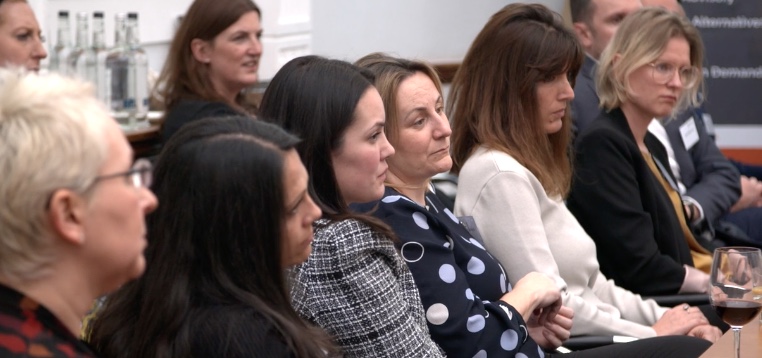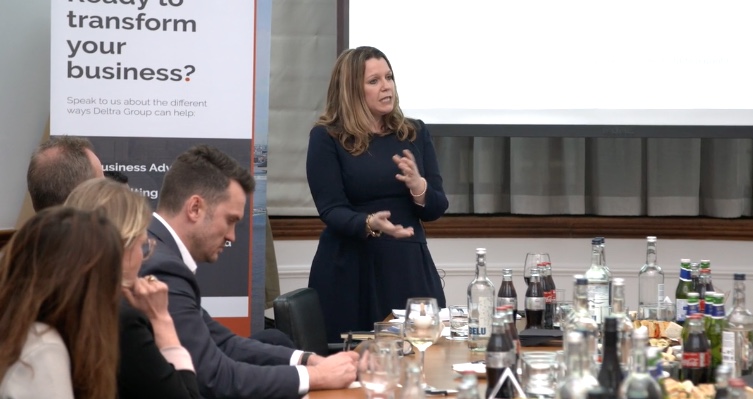Women In Transformation: Toppling The 3 Pillars of Bias in Your Organisation
On the 28th of January the Deltra team once again invited industry leaders within the business transformation space to an evening of discussion on the role of gender bias in business, the true risks it poses and how to address it.
As you may have gathered by now, seeing more talented women make it into the upper echelons of senior leadership is a priority to us at Deltra. That’s why we were delighted to be able to welcome Anna Barsby to our third instalment of the Women In Transformation event series to talk to us all about how to truly shatter the glass ceiling in your organisation.
Anna is a people and change leader in the retail industry who has been celebrated for her unique leadership style and many achievements including winning ‘CIO Of The Year’ in 2014 and making it into the Top 15 Innovative Influencers in Retail in 2018. Having worked for huge names in the retail space such as Morrisons, Halfords and Sainsbury’s – Anna soared to the peak of her career, experiencing lots of different environments on the way and honing her signature management style.
Something that Anna made abundantly clear is that the current state of affairs, where a mere 8% of the CIO population is female, is at the detriment of businesses across the globe. We’re not doing what we can to enable these fantastic women from junior to middle management to come through the ranks.
To be able to prevent bias, we need to be able to face up to it and admit that it’s there. Anna took us through the three pillars of bias present in any organisation: leadership, processes and quotas – and most importantly, how to tackle them head on.
Biased Leadership
There’s no doubt that leadership has remained fairly un-diverse until recent years, with 92% of CIOs being male and so few women sitting on boards. But even as more women began to slowly filter up through management, they were quite often mimicking male characteristics to fit in. Leadership as we know it has been created with men in mind, which leaves no room for typically more female traits like emotional intelligence.
Many often think they have to be brash, loud and assertive to make it into senior management as a woman – this ends up creating a systemic problem which only seeks to further suppress female traits and elevate traits more typically seen in men. This ultimately leads to a hostile and exclusionary culture for anyone who doesn’t share those qualities, resulting in poor staff retention rates and even worse progression.
The danger in biased leadership is that if softer leadership qualities are not rewarded or valued, it sends a strong message that there’s only one way to lead and be recognised for it. One attendee spoke of the impact of having no female role models to inspire or encourage more women to apply for more senior roles. “You can understand why women end up reverting to a more masculine style of leadership, because what have we got to look up to and learn from?”
Another attendee also admitted to empathising with those who adopt more male traits to ensure they are heard, “As a senior leader in the business, I don’t want to have to wield my power in meetings to be taken seriously. But often, if I don’t, people assume I’m the assistant.”

Biased Processes
Many of our processes within our businesses are biased without us even knowing it. Even the way your organisation books meetings and calls in can be biased. For instance if you’re always finding meeting requests in your diary during the school run – there’s a good chance your organisation is unwittingly alienating those with young families.
While one could argue that this alienates parents as a whole, this affects women more than it does men as society still very much sees women as the primary caregivers. For instance, one attendee highlighted that while some female attendees had been described as the team’s mother figure – he has never been referred to as fatherly for exhibiting the same traits.
Furthermore, you only need to look at the personal lives of those in leadership who often sustain this “constant availability” style of working. Generally speaking, many who sit in the c-suite tend to be slightly older and their children may have already flown the nest. So they don’t mind staying late, but it doesn’t always occur to them that others may not share those circumstances.
Additionally, recruitment processes are inherently biased a lot of the time. People are often guilty of recruiting in their own image, most of the time it’s entirely unconscious, which makes it difficult to recognise and stop. All the more reason why involvement in the recruitment process shouldn’t live and die with the hiring manager as there’s less chance of it being picked up.
Not only does this spell disaster for a balanced gender and racial split, but it also creates an echo chamber-like environment that could be hampering your organisation’s progress in the market. All successful teams need a healthy balance of different skillsets and ways of working, Anna pointed out, “If you consistently recruit in your own image, you’ll just end up with a whole team that thinks like you do. And in business, that just doesn’t work.”
Many are already doing their best to cut bias in their recruitment processes by insisting on a 50/50 candidate split, one attendee elaborated on this, “Even if there are only two candidates in the pool who happen to be male, we demand that they match that number in women too so that we stand a chance at hiring a woman.”
She continued, “You’re not hiring for gender, you’re hiring for talent. But to exclude potential female talent from your hiring pool because they are harder to find means you might not be finding the best person for the role and your team as a whole.”
Biased Quotas
Ironically, the very system that was put in place to try and keep bias at bay is actually driving more unfairness. Gender quotas may seem like the antidote to our diversity problems, but in actual fact all it does it solidify harmful beliefs in many cases.
Often what happens when a promotion or recruitment quota is introduced is that the loudest or sometimes most “male” woman in the business ends up winning the race. This then creates a systemic problem where the future role model ends up perpetuating the exact same exclusionary behaviours that her predecessor did. Anna stresses that in this eventuality, nothing ever changes.
So how is this any worse than what’s currently going on? Surely having good intentions that don’t quite follow through is better than not trying at all. Unfortunately the illusion of progress can hamper real progress by pacifying our desire for action while actually feeding the problem.
While it’s important to try to put measures in place to prevent an unbalanced workforce, for instance introducing a diverse hiring pool, we need to stay far away from having a preconceived idea of the gender or race of the successful candidate.

What’s the solution?
With so much bias in society as a whole but more specifically in the transformation space, be it conscious or unconscious, what can we do to see positive change within our own organisations?
There are a lot of misconceptions about being a woman in senior leadership that we need to dispel if we stand a chance at encouraging more females to progress to board level. For instance many presume that to be a CIO you need to work all hours of the day, when in actual fact Anna is proof that you can stick to core working hours, still attend parents evening and have an illustrious career.
We need to make sure that those interested in pursuing c-suite roles know that they won’t be expected to sacrifice their family lives to get ahead. These people typically already work extremely hard, so the thought of having to double or triple that output makes the concept of leadership somewhat off-limits. The best way to achieve this is to lead by example and establish clear boundaries, whether it’s saying no to meetings booked outside of core working hours that exclude members of your team or enforcing a family leave policy.
This is entirely within the realms of possibility as one attendee referenced how she champions for a condensed working week for everyone, which means that those without kids as well as parents can ‘work smarter’ for a reduced working week.
Aside from accessibility being a barrier, there’s also the challenge of making a typically male dominated industry attractive to women and drive a more balanced workforce. Making an effort to attract more women into the sectors that are experience both a skill shortage and a lack of diversity is a serious win.
One of the members of the group highlighted that 52% of STEM graduates are in fact female, so as business leaders we need to try harder to attract them as less than 30% actually make it into the workforce. This is something that many attendees are keenly aware of and a fair few people round the room relayed some success stories of initiatives taking place in their businesses to attract a better gender split.
Several attendees referenced mentoring and internship schemes within their organisations which were geared specifically towards making typically male spaces more attractive to females, which is an excellent step in the right direction.
As much as attractive perks like true flexible working, family leave and a good work life balance matter – it became apparent that the way to truly attract talent is ultimately to fix the biased processes in your organisation first and foremost. As one attendee put it: “It’s all well and good having great policies on the front end but that needs to be reflected throughout your business.”
At Deltra, we’re trying to do our part to shatter the glass ceiling that remains an issue for many women trying to break into senior leadership. We’ve recently set up a mentoring programme for females looking to commit to enriching their personal and professional development. If you’re interested in joining as a mentee, mentor or perhaps even both – head over to our mentoring page to find out more.
18th March
Events Women in Transformation
Related insight
Related News
Looking to
transform?
Quicklinks

Address
Deltra Group
52-54 Gracechurch St
London
EC3V 0EH
Contact
+44 (0)207 375 9500
info@deltragroup.com



